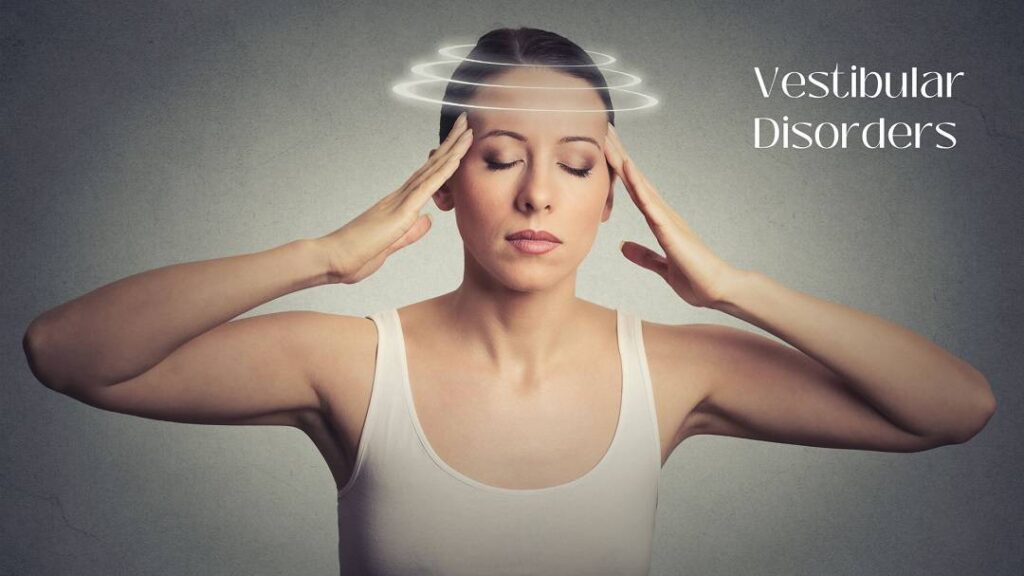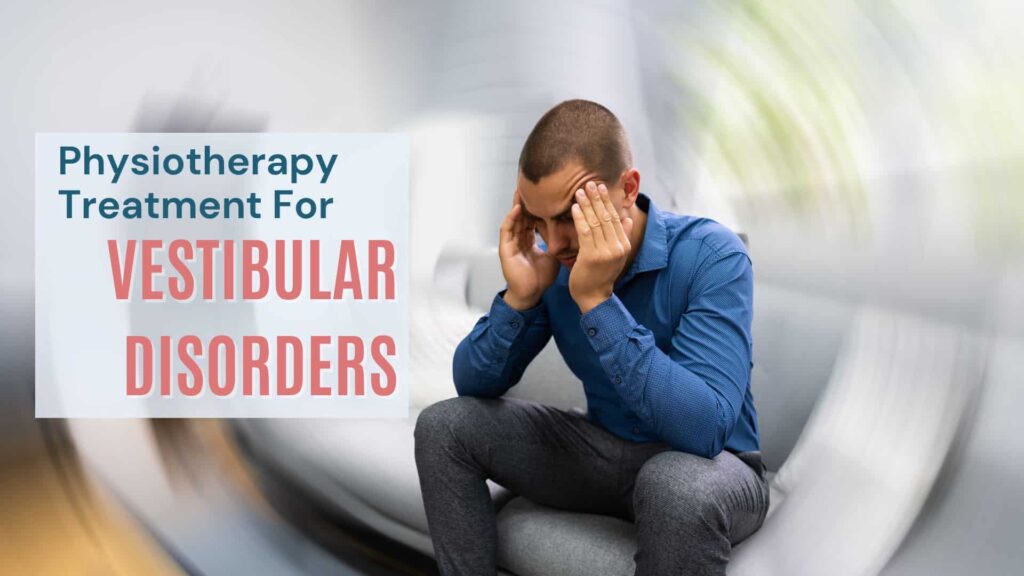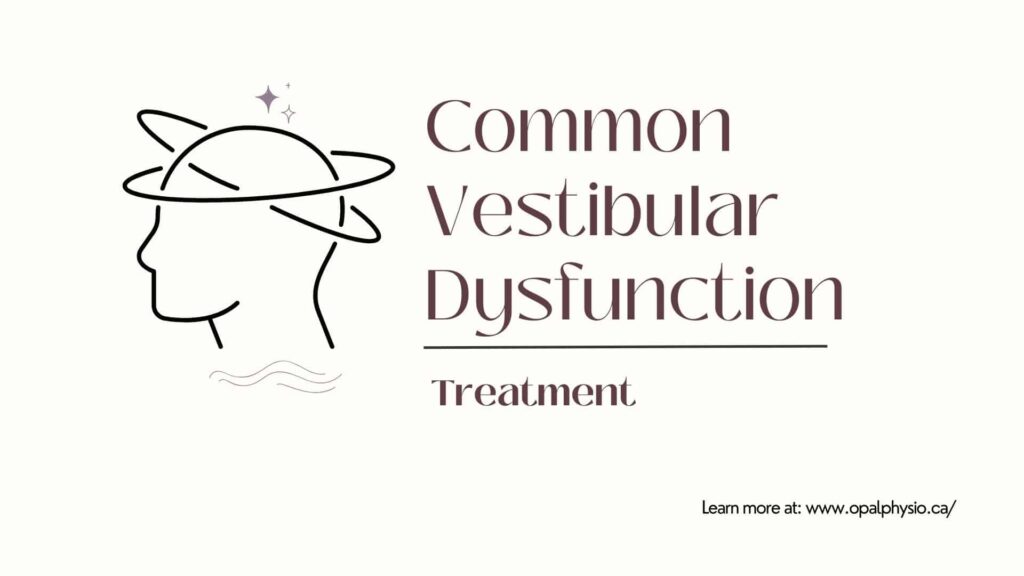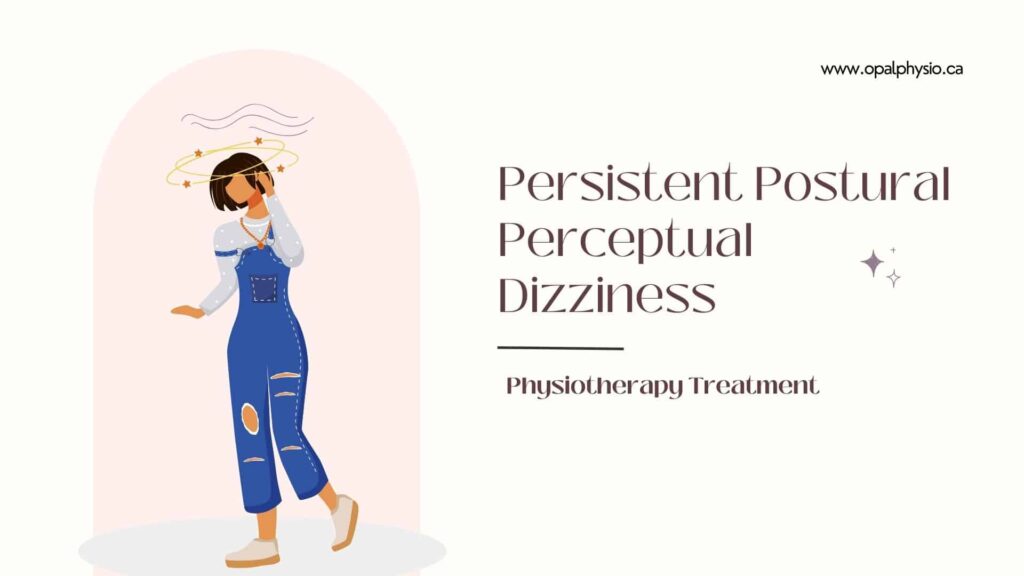Vestibular Disorders Physiotherapy Treatment
If you suffer from vestibular disorders, you know how debilitating the conditions can be. You may feel like you’re constantly off balance and suffer from vertigo, nausea, and headaches. But don’t give up hope! Help is available, and you can get your life back with the proper treatment. Physiotherapy can help treat vestibular disorders with Vestibular Rehabilitation Therapy (VRT).
Opal Physio, a leading physiotherapy clinic for vestibular disorders in Langley. Through Vestibular rehabilitation therapy we provide assessment, diagnosis, and treatment of vestibular disorders, which can affect your balance and coordination, causing dizziness, vertigo, and nausea.
Our vestibular disorders physiotherapy treatment is designed to help you regain your balance and reduce your symptoms. Our experienced physiotherapists use a combination of manual therapy, exercise therapy, and education to provide effective treatment for vestibular disorders.
Vestibular rehabilitation therapy is a type of physical therapy that can help improve balance and reduce symptoms associated with vestibular disorders.

What are vestibular Disorders?
Vestibular disorders are medical conditions that affect the inner ear and result in a disturbance of the vestibular system. The vestibular system is responsible for our sense of balance and spatial orientation. When there is a problem with the vestibular system, it can cause a variety of symptoms, including dizziness, vertigo, and unsteadiness.
The inner ear’s primary function is to monitor motion and send information to the brain about where the head is in space so that you can move your body accordingly. As a result, the disorders that affect this area are a collection of conditions that cause balance problems, dizziness or sudden attacks of vertigo, hearing loss, and tinnitus (ringing in the ears) due to damage to these structures.
Balance issues may affect anybody at any age, although they tend to become more prevalent as you age.

Are you experiencing Vertigo and Dizziness From Vestibular Disorder- Our Vestibular Physio can Help!
Daily life and work activities become very challenging when a vestibular dysfunction occurs, whether from an injury/accident or illness. As a result, one may have significant imbalance problems, nausea, and dizziness.
Our vestibular physiotherapy aims to provide positional maneuvers treatment or exercise-based Vestibular Rehabilitation Therapy (VRT) to help improve symptoms and quality of life for patients with vestibular disorders. The goals of VRT may include reducing dizziness and vertigo, improving balance and coordination, and increasing activity levels.
Causes And Risk Factors For Vestibular Disorders
Many risk factors have been associated with vestibular disorders, including age, genetics, head trauma, viral infections and medications. In addition, certain medical conditions can also cause vestibular disorders, which include autoimmune disorders, migraines and allergies.
Many factors can cause vestibular disorders; therefore, it is important to see your doctor if you suffer from vertigo or dizziness. They can conduct tests to determine the contributing factors that might be causing your condition.
Symptoms Of Vestibular Dysfunction
Vestibular disorders can cause a variety of symptoms, and some common symptoms include:
- Dizziness
- Vertigo
- Imbalance
- Spatial disorientation
- Unsteadiness
- Nausea/vomiting
- Visual disturbances
- Fatigue
- Anxiety/panic attacks
- Irritability
- Depression:

Common Vestibular Disorders
Some of the common vestibular disorders that can affect the vestibular system and their associated symptoms and their physiotherapy treatment options are given below:
Benign Paroxysmal Positional Vertigo (BPPV)
Benign Paroxysmal Positional Vertigo (BPPV) is a condition that affects the inner ear and can cause dizziness. It occurs when tiny calcium crystals become dislodged and float into one of the fluid-filled semicircular canals in the inner ear. This can happen due to head trauma, viral infections, or changes in pressure or position.
BPPV can cause mild to severe vertigo, which is a sensation of spinning or whirling with changes in head movements. It can also cause nausea and vomiting. BPPV Treatment usually involves a series of BPPV physiotherapy maneuvers designed to move the calcium crystals out of the affected canal.
Meniere’s Disease
Meniere’s disease is a disorder of the inner ear that causes sudden episodes of vertigo, ringing in the ears, a feeling of fullness or pressure in the ear and hearing loss. It can also cause nausea and vomiting during the episode.
It is thought to be caused by a buildup of fluid in the inner ear, although the exact cause is unknown. Meniere’s disease is a chronic condition, and there is no cure. Instead, treatment focuses on managing symptoms and preventing further damage to the ear.
The effects of Meniere’s disease can be managed with physiotherapy, which usually involves a combination of lifestyle changes and exercises. Therapists can offer suggestions for safe mobility during and between episodes and guide patients through lifestyle adjustments. Physical therapy can also assist with exercises to help manage symptoms such as vertigo, imbalance and unsteadiness that you can encounter between episodes.
Vestibular Neuritis
Vestibular neuritis, also known as vestibular neuronitis, is a condition that affects the vestibular nerve, which is responsible for sending balance and spatial information from the inner ear to the brain. It is usually caused by a virus that could affect the nerve. This can cause symptoms such as dizziness, vertigo, and nausea.
Vestibular physiotherapy treatment can help to improve vestibular function and reduce associated symptoms. This may involve exercises to improve balance and coordination and strategies to help manage dizziness and nausea. With vestibular physiotherapy, the progress is usually good. However, recovery ensues more effectively when the vestibular exercises are initiated earlier.
Acoustic Neuroma
Acoustic neuroma is a benign brain tumour arising from the Schwann cells of the vestibular nerve. This type of tumour is also known as a vestibular schwannoma. It is a tumour growing on the nerve connecting the ear to the brain. This nerve is responsible for balance and hearing. Acoustic neuromas can grow to a large size and compress nearby structures, which can cause a variety of symptoms, including hearing loss, tinnitus, balance issues and vertigo.
Physiotherapy treatment focuses on managing the symptoms caused by post-acoustic neuroma with vestibular rehab. This may include exercises to improve balance and coordination and manage vertigo and nausea. In some cases, physiotherapy may also help patients cope with hearing loss.
Unilateral Vestibular Hypofunction
Unilateral vestibular hypofunction (UVH) is a condition that results in a loss of function of the vestibular system on one side of the body. This can lead to many symptoms, including dizziness, imbalance, and difficulty with vision.
A head injury, stroke or other neurological condition causes unilateral vestibular hypofunction. Infection or tumour can also cause nerve damage in the inner ear. These patients cannot turn their heads to the side on the affected side (i.e. weakly to the involved right or left). They have difficulty walking in a straight line and often have problems with their spatial awareness or perception of their body within space, which may lead them to bump into objects or other people. These patients can also be uncoordinated and have poor posture due to their inability to sense where their body is in relation to its surroundings.
Vestibular physiotherapy is a treatment that targets many of the symptoms associated with vestibular hypofunction. Physiotherapy treatment for UVH typically focuses on exercises that help to improve balance and coordination with retraining exercises. These exercises may be done with or without the assistance of a therapist, depending on the severity of the condition. In addition, patients may be taught how to perform certain maneuvers to help ease symptoms.
Bilateral Vestibular Hypofunction
Bilateral vestibular hypofunction (BVH) is a condition in which the vestibular system fails to function properly. The vestibular system is responsible for our sense of balance and equilibrium. It does this by sending signals to the brain about the body’s position in space. In individuals with BVH, the vestibular system becomes unbalanced, causing unnatural weight shifts and resulting in symptoms such as dizziness, lightheadedness, unsteadiness of movement or balance, and oscillopsia (i.e., seeing things swaying).
Physiotherapy treatment for BVH may include exercises that help to improve balance and eye movement. Balance training is an effective treatment option for this condition. Treatment may also include vestibular rehabilitation, a therapy that helps to retrain the vestibular system.

Persistent Postural Perceptual Dizziness
Persistent postural perceptual dizziness (PPPD) is a condition that can cause a person to feel dizzy or unsteady when they are in a certain position. A number of different factors can cause PPPD; some potential causes include head injury, postural hypotension (low blood pressure), migraine or other visual disturbances, vision problems, medications/illnesses (including diabetes), Stress or anxiety, and neck problems.
PPPD typically sets in shortly after an event that causes acute vertigo, unsteadiness, dizziness, or balance disruption. Sitting or lying down in a quiet location improves the sense of dizziness.
Vestibular rehabilitation therapy can help to alleviate the symptoms of PPPD. Physical therapists will teach you balance and walking exercises. Additionally, therapists will instruct you in acclimatization activities to help you handle movement and visual stimuli. The effects of habituation exercises help improve the symptoms, and this sort of treatment requires supervision by the physical therapist in the clinic and continuing exs from home prescribed by your therapist.
Mal de Debarquement Syndrome
Mal de debarquement syndrome (MdDS) is a condition that can occur after exposure to repetitive motion, such as that experienced during the boat, ship travel or other forms of watercraft for an extended period. The symptoms include chronic dizziness, rocking or swaying sensation even when there is no movement, vomiting and lethargy. This can last for days, weeks, or even months after the initial exposure. MdDS is a type of vestibular disorder affecting the inner ear and the way the brain processes information about movement and balance.
Physiotherapy treatment for MdDS typically focuses on vestibular rehabilitation, a therapy that helps the brain learn to better process information about movement and balance. This can be done through various exercises and activities that help retrain the brain for vestibular information.
Cervicogenic Dizziness
Cervicogenic dizziness is a condition that can be caused by problems in the neck. It is a type of dizziness often accompanied by neck pain or headache. Physiotherapy treatment can help to reduce the symptoms of cervicogenic dizziness.
A highly skilled, licensed physical therapist will evaluate you at Opal Physio to identify the factors contributing to your cervical condition. These factors may include your cervical and upper thoracic spine mechanics, range of motion, soft tissue mobility, muscle strength, joint movement, postural alignment, body mechanics, and quality of movement during routine daily activities.
Physiotherapy treatment may include exercises to improve the range of motion and flexibility in the neck, as well as manual therapy techniques to help relieve pain. In addition, physiotherapy treatment approaches include vestibular rehabilitation therapy, postural retraining and exercises, and management of cervical muscle spasms and headaches.
Post Concussion Syndrome
Post-concussion syndrome (PCS) is a condition that can occur after a person has suffered a concussion post-traumatic brain injury. Symptoms of PCS can include headache, dizziness, exhaustion, irritability, anxiety, sleeplessness, and difficulty concentrating. While most people who suffer a concussion will recover within a few weeks, some people may develop PCS.
There is no specific treatment for PCS, but physiotherapy can help manage the symptoms. Physiotherapy can help to improve balance and coordination, as well as reduce fatigue and headaches. A physiotherapist can also provide exercises to help improve cognitive function. If you are suffering from PCS, seeking medical help and advice is essential to ensure you receive the best possible treatment.
Specific physiotherapy treatment includes vestibular rehabilitation therapy, Cognitive behavioural therapy, cervical spine stabilization exercises, eye exercises, balance training exercises and more.
Treatments for Vestibular Disorders
Vestibular disorders can cause dizziness, imbalance, nausea and other vestibular symptoms. While there is no cure for vestibular disorders, there are some treatment options that can help to manage the symptoms and improve quality of life. Treatment for vestibular disorders depends on the type and severity of the condition.
Vestibular rehabilitation therapy is one such treatment, which is a form of physical therapy that helps to retrain the brain to process information from the vestibular system to improve balance and coordination. Other treatments include medications and lifestyle changes for vestibular suppressants, which can help to reduce dizziness.
If you are experiencing vestibular disorder symptoms, it is important to see a doctor for a proper diagnosis and treatment. Vestibular disorders can be debilitating and significantly impact your quality of life. However, several treatment options are available for vestibular disorders, and the sooner you seek help, the better your chances of recovery.
Physiotherapy treatment for Vestibular Dysfunction
Vestibular rehabilitation is a physiotherapy treatment that aims to help individuals who suffer from vestibular disorders. Vestibular rehabilitation uses repetitive exercises to help retrain the brain and nervous system to compensate for any dysfunction caused by these problems with the inner ear and its connections.
Physiotherapy treatment at Opal Physiotherapy for vestibular dysfunction is done under the guidance of a physiotherapist trained in vestibular rehabilitation techniques. The course of treatment will depend on the severity of the symptoms and may take weeks or months to complete. The daily exercises are designed to be done at home and are supervised by our physiotherapist during regular in-person sessions.
Vestibular rehabilitation with your physiotherapist will help reduce your dizziness and improve your balance. The goal is to help your body maintain balance and stability when you move around.
Our physiotherapist at Opal physio has experience in treating patients with vestibular disorders. They use physical therapy treatments involving vestibular exercises such as positional maneuvers, lifestyle modification, myofascial release, and VRT to address balance disorders, dizziness or vertigo.
Contact our physiotherapy clinic in Langley to help with your vestibular disorders.
